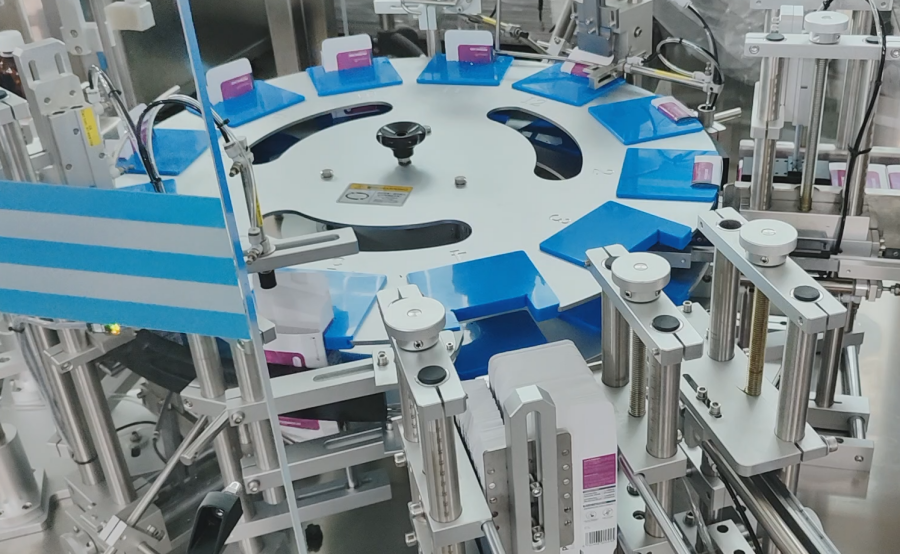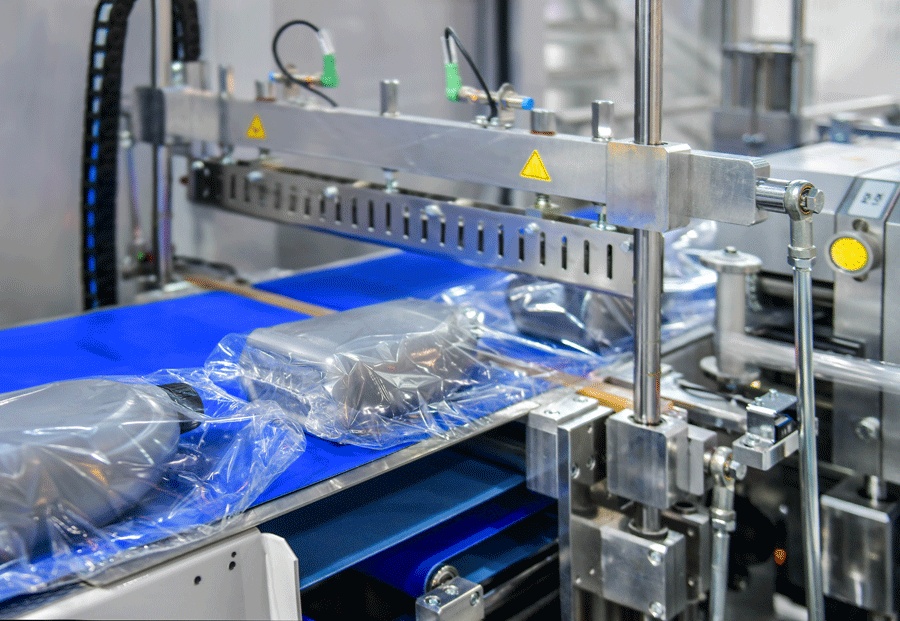Technology is impacting every industry, and pharmaceutical production is no exception. From improving research processes to quick and efficient drug production, it can handle all.
Many pharmaceutical companies are now investing in technological products, and the pharmaceutical technology market size is expected to reach $147.5 billion by 2028.

Want to know more about pharmaceutical production technology trends and their impact? Continue reading!
Top Pharmaceutical Production Technology Trends
The following are some amazing pharmaceutical production technology trends that you should follow to streamline your operations:
Integration of IoT
Pharmaceutical production requires optimal environmental conditions, including stable temperature and clean air. Manually tracking and managing these metrics is a huge hassle. However, integrating IoT within your manufacturing facility can be a great step.
IoT or Internet of Things actually comprises a network of devices and sensors that gather critical data, process it, and then transmit it. Some sensors use an Ethernet cable to connect with the internet, while others operate wirelessly, relying on protocols like Bluetooth and Wi-Fi.
Here’s an overview of the IoT sensors frequently used in pharmaceutical manufacturing:
Temperature Sensors
IoT temperature sensors continuously collect temperature data from various points within the production process, including manufacturing equipment and storage areas.
They use thermocouples, RTDs, and thermal imaging. This data is then transmitted to a central hub or dashboard.
If the temperature deviates from the pre-defined acceptable ranges, the system issues alerts for prompt action. Examples include faulty electrical connections in control cabinets and overheating due to blocked filters.
Humidity Sensors
Along with temperature, humidity is an important parameter in pharmaceuticals that requires precise control and monitoring. IoT humidity sensors enable real-time and continuous monitoring of humidity levels in production facilities and cleanrooms.
Based on the collected data, the staff can then adjust conditions as needed.
These sensors ensure that powders stay dry and coatings also dry at the required speed, preventing drug spoilage and degradation. For instance, multiple sensors are used in the HVAC system to ensure the air quality remains within a strict limit.
Well, the IoT role isn’t limited only to pharmaceutical production technology; it also facilitates the smooth transit and delivery of drugs. It eliminates issues like temperature fluctuations, vehicle accidents, and conveyance losses.
GPS and sensors on vehicles provide information about their location and performance, preventing sudden breakdowns. In addition, RFID tags facilitate the quick identification and distinguishing of drugs.
3D Printing
Another popular trend in pharmaceutical production technology is the adoption of 3D printing. Traditionally, medicines are manufactured in a limited number with discrete strengths using methods that were invented more than 200 years ago. However, these medicines aren’t suitable for all patients and don’t always deliver the desired therapeutic effects.
Studies show that in the UK, up to 70% of patients do not gain efficacy from traditional mass manufacturing approaches.
But there’s nothing to worry about, as 3D printing is now paving the way for personalized drug development. Pharmacists and drug manufacturers use computer-aided design CAD to create a digital blueprint of the medication, specifying desired shape, size, and drug combination. It’s then 3D printed using stereolithography (SLA) and extrusion-based printing. Patients then experience better drug delivery and improved therapeutic outcomes.
AI and ML
AI and ML are powerful tools that are transforming pharmaceutical production processes. How? Well, conventional drug discovery was a long and complex process, taking years. AI speeds up this whole process by analyzing large datasets, including chemical, biological, and clinical data.
It uses Machine Learning to find potential drug candidates, shortening the pharmaceutical development cycle and reducing overall costs. In addition, it can predict how different molecules interact with biological targets, allowing you to find the compound with the highest efficacy.
What’s truly amazing is that AI can help you find the ideal candidate who can benefit from the new drug and also outline its adverse effects, eliminating the risk of failure. Some other ways AI proves to be an amazing pharmaceutical production technology are:
- AI algorithms can analyze complex genetic data to identify mutations and biomarkers associated with a disease, so you can make precise medications for it.
- It can predict demand for a specific drug or medication in a particular area, allowing you to optimize production accordingly.
- AI can forecast equipment failure and other production bottlenecks to minimize downtime and maintain smooth operations.
Robotics
Nowadays, you see robots in hotels and even corporations. But do you know robots are also among the top pharmaceutical production technology trends? Yes, it’s true! Pharmaceutical manufacturers rely on advanced robots to screen potential drug compounds and autonomously synthesize new molecules.
They also identify patient biomarkers for personalized drug development. But there’s more; robots are programmed to accurately fill in small doses or volumes of medications. There’s no room for human error, and all produced batches have a uniform concentration, which significantly improves customer satisfaction and trust.
There are also some cobots, also known as collaborative robots, that work alongside human workers. You can program them to automate routine tasks, such as drug filling, to increase output and reduce production time. The best part is that these cobots carefully inspect medications for safety and quality, ensuring patients receive efficient results.
Digital Twin Technology
At its core, digital twin technology creates a real-time virtual replica of a physical asset, process, or system. It’s quickly making its way to pharmaceutical production, helping in quick and cost-effective drug development.
For instance, you can use digital twins to simulate drug responses and predict critical quality attributes (CQAs). Not only this, but you can also rely on them to simulate clinical trial scenarios, reducing the need for extensive human intervention.
It helps in quality control and cuts down overall production expenses. According to McKinsey, the average chemical QC lab can reduce costs by 25 to 45 percent by reaching the digitally enabled lab horizon.
Blockchain
You’ll also see a frequent use of Blockchain as pharmaceutical production technology. Typically, Blockchain is an advanced database mechanism that allows transparent information sharing within a business network. In the pharmaceutical industry, Blockchain is really helpful against the distribution of counterfeit medications.
It gives you insights into how drugs travel from your production facility to the end consumer. For instance, you get information about the drug’s origin, production date, and batch details. All this eliminates the chances of tampering and builds trust.
Benefits of Pharmaceutical Production Technology
Many companies and drug production units still hesitate to implement advanced pharmaceutical production technology solutions. If you are one of them, here are some compelling reasons to invest in them:
Cost Savings
While the investment in pharmaceutical production technology seems high, it offers long-term cost savings. For instance, IoT sensors help maintain optimal environmental conditions, which reduces drug spoilage and overall product wastage.
Moreover, high-tech machines automate repetitive tasks, such as dosage filling and packaging.
This allows you to save money on labor costs and also get rid of increasing rejection rates. Some technological solutions are even designed to be energy efficient, so you save money on energy bills and also lower your carbon footprint.
Regulatory Compliance
Regulatory compliance is a must, especially for businesses dealing with sensitive materials like medications. Therefore, one of the reasons to invest in pharmaceutical production technology is to enhance your compliance with industry standards.
You have access to electronic batch records and quality management systems (QMS) that track each step of the manufacturing process. In addition, you have proper documentation and traceability that make audits faster and less stressful.
Faster-Time-to-Market
The competition in the pharmaceutical industry is soaring high. To stay ahead, you need to launch high-quality products within a minimum time. Again, this task can be taken over by pharmaceutical production technology.
There are robots that handle clinical trials and biomarker identification.
In addition, the digital twin technology simulates products and their results before actual launch to predict outcomes. All this allows you to speed up production; hence, your products have a faster time to market.
Better Process Control
Advanced sensors and devices give you real-time insights into critical parameters. You can adjust the temperature, pressure, and air quality inside a fermenter or reactor to achieve the desired drug efficacy. This much process control leads to fewer deviations and consistent product batches.
FAQs
What roles does automation play in pharmaceutical production?
Automation plays an important role in pharmaceutical production by reducing errors, lowering costs, increasing production speed, and providing a competitive edge.
What is a cleanroom, and why is it essential in pharmaceuticals?
A cleanroom is a controlled environment with little to no contaminants necessary for sterile drug development. There’s no risk of airborne particles, dust, microorganisms, and chemical vapors interfering with a drug’s composition.
What are electronic batch records?
Electronic batch records are actually digital versions of paper-based batch records. These systems capture and store all the data generated during production processes, ensuring accuracy, compliance, and efficiency.
Conclusion
Whether you are a small pharmaceutical production company or a big one, you must invest in pharmaceutical production technology. This way, you’ll be able to automate most of your tasks and launch products quickly in the market while adhering to safety and quality standards.
Wondering where to find top-notch pharmaceutical machinery for your daily tasks? Look no further than Finetech. We have a wide range of durable equipment that’s sure to meet your needs.






